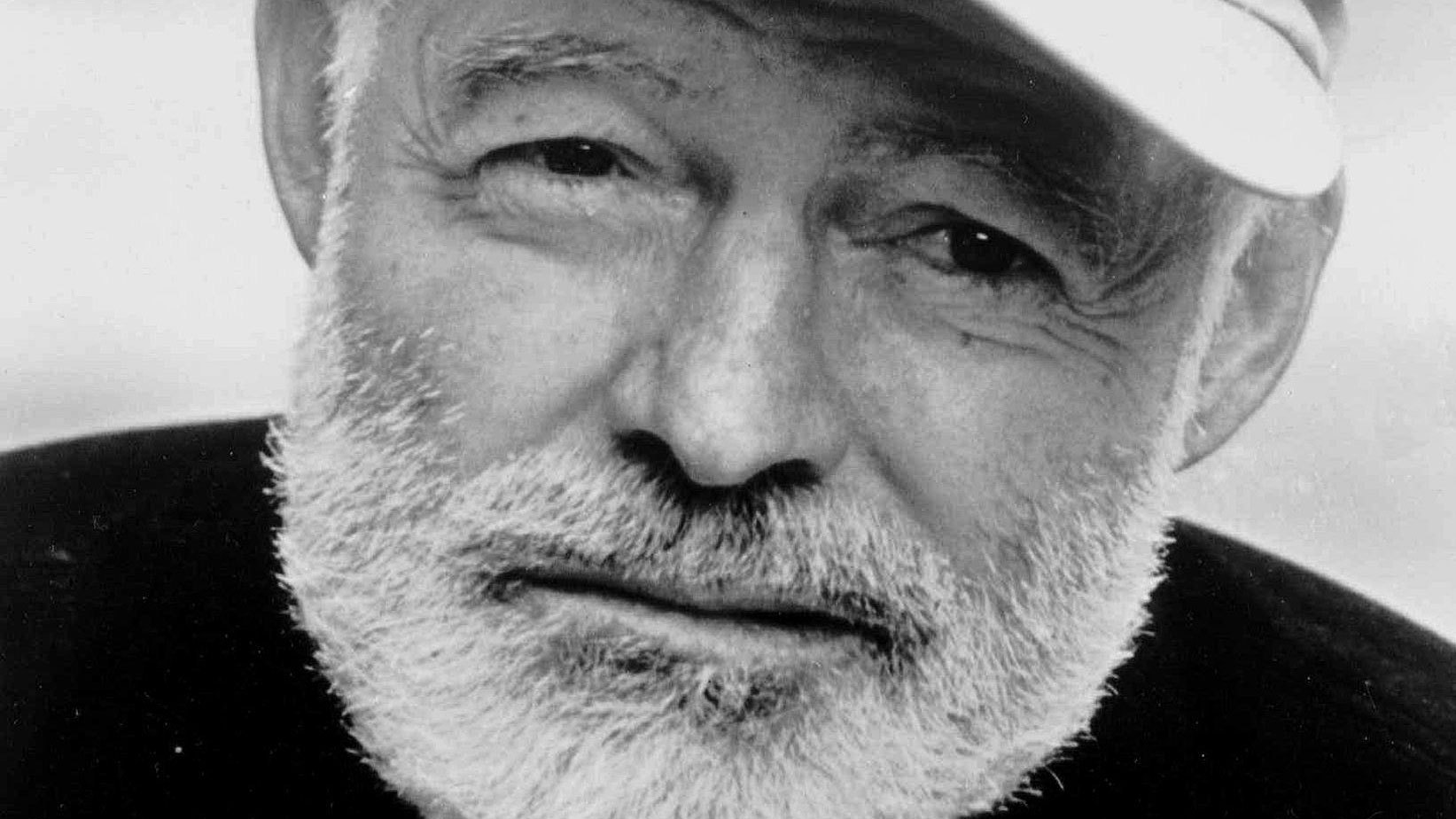One of the books on grandfather’s shelf when I was growing up was, The Short Stories, by Ernest Hemingway.
I used to love reading The Killers, My Old Man, and The Battler especially.
Over the weekend I dusted the old book off, read it cover to cover, and made a few notes…
Hemingway started his career as a journalist, eventually translating much of what he learned from crusty old newspaper copy chiefs to the telling of short stories.
In many ways, this transplanting of the sparse reporter’s style to the realm of dramatic writing was what made him one the most influential writers of the 20th century.
Personally, I think there are important parallels to copywriting and web marketing in both of these disciplines.
A journalist answers the questions who, when, where, what, and why – as directly as possible. He catalogs the facts in decreasing order of importance. And tries to personalize the story, making it seem more relevant and important to his audience than it probably is. The storyteller, the opposite…
Instead of punching the audience in the nose with his main point as quickly as humanly possible, he teases the reader along. Gradually, lifting the veil on the point he’s chosen to make. Questions are raised… dramatic conflict revealed… and slowly paid off.
As copywriters we need to be skilled in both of these disciplines. That’s why I think there’s a lot we can learn from Hemingway. He excelled at both.
The first thing you’ll notice when you read these stories is their simplicity. The minimalism is striking …
Jim Gilmore came to Horton’s Bay from Canada. He bought the blacksmith shop from old man Horton. Jim was short and dark with big mustaches and big hands. He was a good horse-shoer and did not look much like a blacksmith even with his leather apron on. He lived upstairs above the blacksmith shop and took his meals at D.J. Smith’s.
His descriptions generally consist of short declarative sentences. They use simple Anglo Saxon derived words which tend to have clear unambiguous meanings. And you find few adjectives. The above paragraph reads at a 4th grade level.
What are the implications of such style when it comes to sales copy?
Well, since many people in America lean toward functionally illiteracy, it means your message is more likely to be understood. That can’t be a bad thing.
And when your copy is simple and straightforward like this, it has the ring of truth. You appear open and honest.
Hemingway’s writing is also quite lyrical. He uses a lot of alliteration, repetition, and rhythm. But it’s subtle, never calling attention to itself.
Your Ear Is Seduced. The Words Begin to Flow Effortlessly, Almost Like Music…
As example, look at the repetitive s sound throughout the first part of the following paragraph. Look at the counterpoint between the second and third sentences, beginning with the words outside and inside respectively. And notice the 4, 3, 2, staccato rhythm in the final two sentences, both beginning with h and ending in f.
So he ate an orange, slowly spitting out the seeds. Outside, the snow was turning into rain. Inside, the stove seemed to give no heat and rising from his writing table, he sat down upon the stove. How good it felt! Here at last, was life.
Great sales copy is lyrical too. Unconsciously, a skilled copywriter strings words together in ways that are pleasing to the ear. He constructs sentences that flow smoothly from one thought to the next. And he beats out a hypnotic rhythm that mesmerizes the reader, just like Hemingway did.
Probably the most significant thing about Hemingway’s writing is the way he makes you empathize with the characters in his stories. Nowhere does he describe their emotions. It’s up to you, the reader, to conclude their feelings, values, and motivations – from their actions… from their dialog… from other character’s reactions to them… and from the decisions they make. Just as you do in real life.
Nothing is what it seems on the surface. Every word is carefully calculated to imply something deeper. Abstraction is vigorously avoided. Thus you are given the opportunity to experience the character’s feelings first hand.
Liz liked Jim very much. She liked it the way he walked over from the shop and often went to the kitchen to watch for him to start down the road. She liked it about his mustache. She liked it about how white his teeth were when he smiled. She liked it very much that he didn’t look like a blacksmith. She liked it how much D.J. Smith and Mrs. Smith liked Jim. One day she found that she liked it the way the hair was black on his arms and how white they were above the tanned line when he washed up in the basin outside the house. Liking that made her feel funny.
Hemingway could have written, “Liz had a crush on Jim.” But there’s nothing concrete about that. We understand it intellectually. But we don’t feel the giddy madness of a teenage girl experiencing her first heat.
Isn’t that what copywriting is really all about? Not necessarily teenage love, but evoking a specific emotion – an emotion that makes your prospect want to act on your sales proposition. If you want to create those kinds of emotions, do like Hemingway did. Lead your prospects to the meaning by showing instead of telling.
The Iceberg Principle…
Hemingway believed a writer should know his subject so well that he could omit great tracts of it and the reader would still get a sense of its totality.
To understand the true significance of this, consider the fact that many of Hemingway’s short stories are almost pure dialog. The Killers is over 90% dialog. Imagine writing authentic sounding dialog while omitting almost all of the exposition, description, and narrative typically used to carry a story.
The Killers are a couple of prohibition era thugs hoping to knock off a Swedish boxer when he comes into a lunch bar for dinner. Hemingway fleshes the story out with nothing but dialog and a little narrative and description.
The door of Henry’s lunch room opened and two men came in. They sat at the counter.
“What’s yours?” George asked them.
“I don’t know,” one of the men said. “What do you want to eat, Al?”
“I don’t know, I don’t know what I want to eat.”
Outside it was getting dark. The street light came on outside the window. The two men at the counter read the menu. From the other end of the counter Nick Adams watched them. He had been talking to George when they came in.
“I’ll have the roast pork tenderloin with apple sauce and mashed potatoes,” the first man said.
“It isn’t ready yet.”
“What the hell do you put it on the card for?”
“That’s the dinner.” George explained. “You can get that at 6 o’clock.”
George looked at the clock behind the counter.
“It’s five o’clock.”
“The clock says twenty minutes past five,” the second man said.
“It’s twenty minutes fast.”
“Oh, to hell with the clock,” the first man said. “What have you got to eat?”
“I can give you any kind of sandwiches,“ George said. You can have ham and eggs, bacon and eggs, liver and bacon, or a steak.”
“Give me chicken croquettes with green peas and cream sauce and mashed potatoes.”
“That’s the dinner.”
“Everything we want’s the dinner, eh? That’s the way you work it.”
“I can give you ham and eggs, back bacon and eggs, liver and–“
“I’ll take the ham and eggs,” the man called Al said. He wore a derby hat and a black overcoat buttoned across the chest. His face was small and white and he had tight lips. He wore a silk muffler and gloves.
“Give me the bacon and eggs,” said the other man. He was about the same size as Al. Their faces were different, but they were dressed like twins. Both wore overcoats too tight for them. They sat leaning forward, their elbows on the counter.
“Got anything to drink?” Al asked.
“Silver beer, bevo, ginger ale,” said George
“I mean you got anything to drink?”
“Just those I said.”
This is a hot town,” said the other. “What do they call it?”
“Summit.”
“Ever hear of it?” Al asked his friend.
“No,” said the friend.
“What do you do here nights?” Al asked.
“They eat the dinner,” his friend said. “They all come here and eat the big dinner.”
“That’ right,” George said.
“So you think that’s right?” Al asked George.
“Sure.”
“You’re a pretty bright boy, aren’t you?”
“Sure,” George said.
“Well, you’re not,“ said the other little man. “Is he Al?”
“He’s dumb,” said Al. He turned to Nick. “What’s your name?”
Nothing said about a couple of Mafia thugs walking into a diner. Not a word. It’s all carried in the dialog and just a few lines of description. Yet you can almost see DeNiro and Pacino, bantering back and forth, can’t you?
Imagine how intimately Hemingway must have known this story in order to be able to tell it like this, with so much of the iceberg submerged.
The dialog is absolutely believable. The thugs have a distinct way of talking. The guy behind the counter has a distinct way of talking.
Shouldn’t You Too Have a Distinct Way of Talking – A Way That Mirrors the Style of Your Prospect?
When you think about it, the “me to you” style of writing I’m doing right now – the kind of writing that comprises 90% of direct response copy – is a kind of dialog. We are talking to our prospects, aren’t we?
If Hemingway can articulate these characters so convincingly, do you think you might be able to do a better job of characterizing yourself as one of your prospect’s kind of people, thus forging a much stronger connection?
You want to know how to do this?
It’s all about finding your prospects in their natural habitat and listening to them with total present moment awareness… listening to not just their words, but also the music of their voices.
Make your way to a bar or restaurant or some other place where they’re all around you. Close your eyes and let the sounds wash over you. Listen to their phrasing and odd verbal ticks. Take in the rhythm.
After a time, forget you even understand the words. Listen as though you were listening to a foreign language. And you’ll begin to understand. Indeed, these are the kinds of pains Hemingway took.
The Iceberg Principle Demanded That Most of Hemingway’s Writing Never Saw the Light of Day…
Page after page after page was for his own benefit, his way of getting to know the world he was creating and the characters in it.
Then edited, rewritten, edited and rewritten, again and again and again – distilled to its raw essence. Every paragraph, every sentence, every word packed with purpose, precision, and the power to evoke passion.
Of course, there are more notes. Perhaps I’ll share them with you another day.
Until next time, Good Selling!
P.S. Veiling your persuasion in riveting stories is probably the best way to increase your sales conversion. It’s made me more money than any other copywriting skill.



Wow, in one short article you have managed to capture what I have read entire books to get. Thus making the point of your article. You have inspired me to get down a story that has been eddying around in my brain for quite some time.
I feel like you have reached out with an encouraging hand and I am grateful!
Thank you!
Dawn
Glad you enjoyed today’s post, Dawn.
I have always loved Ernest Hemmingway’s terse work, but you have given me reason to fall deeper in love, Daniel. Thanks for that!
The “Liz had a crush on Jim” example is great. Really sums up smart writing. A long time ago, a marketer told me, he always wants his readers to come to the conclusion themselves. Write in a way that makes it easy for them to connect the dots and come to the natural conclusion. Much more effective than hitting them over the head.
A truly amazing use of the word “it”.
Thanks Daniel, A well made point, and memorable.
I really love the way you write too, Daniel. You are great! Thank you for this wonderful article, thank you once again!!
Thanks for the compliment, Solomon. Glad you enjoyed it.
You had me gripped from the moment I read the wonderful email that sent me here. To finally understand the method behind Hemingway’s magic has been a real eye opener. Thank you so much.
Hey Quentin, you said it… this is how you keep subscribers engaged and buying over the long term.
Brilliant insights as always, Daniel. Great stuff.
Daniel,
I think this lesson could really apply to the B2B world. There are so many times when companies want to spout off that they’re the ‘greatest’, ‘premier’ or ‘leader in (whatever) category… but that doesn’t really convince, does it?
It’s like saying, “you should have a crush on us,” as ridiculous as that sounds.
Instead, taking a note from this lesson, it would be so much better for companies to learn to trust in copywriting that lets the sale lie below the surface; to draw prospects in with basic dialogue that paints a deeper narrative, as you’ve pointed out here.
So the next time I get push back on this kind of approach, now I know what to say. “Have you ever read Hemingway’s The Killers…? Why do you think that kind of writing draws people in? Well, let me tell ‘ya…”
Thanks for that!
Excellent point, beautifully illustrated. (Sorry about the adjectives.)
I’ll attempt to comment in Hemingway’s prose.
Daniel made the point the reader needed to hear. He showed how Hemingway used language to illustrate his point. Daniel made brief; he made it concise. It carried.
When I revised the last sentence, I left out “it”: “Daniel made it brief.”
This was fantastic! I have read books, watched videos, taken courses in copywriting and sales. Never have I had anyone explain to me HOW to write as simply yet intellectually as you just have. Without all the fluff (which was the point) you made your point through the words you wrote, and displayed your point through their placement, meaning, and the sheer economy of this article. I get lost in most of the other information out there because of the way I think. I like people to get to the point; when they don’t I start to tune out or jump ahead to the conclusion. I can’t stand all the puffery most “internet gurus” use to make what they’re “teaching” appear well-thought out, fleshed out and valuable. Because when you get to the core of their message there isn’t much there. With this article, I literally am thinking back to all of the literature I have read over the years and can apply this to that and see my way clear with my copy—right now! I feel like I’m back in a college classroom having a moment of clarity where everything finally makes sense and the whole course comes together in an instant. Thank you!!! (The length of this comment reflects my excitement over finally “getting it.”)
Hello Lauren, I’m thrilled you got so much value from this week’s post. Thank you for letting me know.